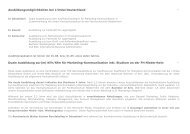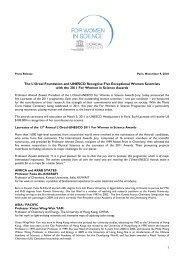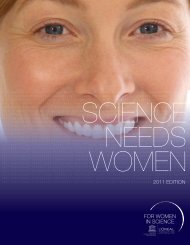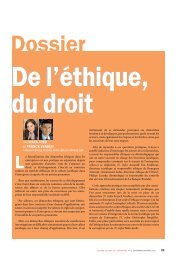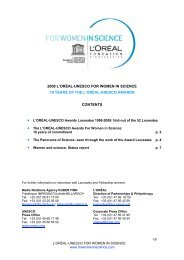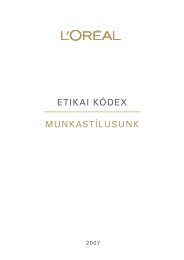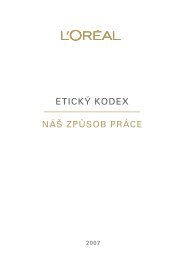CONTENTS - L'Oréal
CONTENTS - L'Oréal
CONTENTS - L'Oréal
Create successful ePaper yourself
Turn your PDF publications into a flip-book with our unique Google optimized e-Paper software.
L’ORÉAL-UNESCO FOR WOMEN IN SCIENCE 2005<br />
L’ORÉAL-UNESCO AWARDS 2005: The Laureates<br />
physics and many people think that this discovery and its<br />
explanation were worth a Nobel recognition.<br />
A large spectrum of creativity<br />
Myriam Sarachik has been interested in the behavior of<br />
systems as they transform from one “phase” to another.<br />
For example, materials can be in the solid, liquid or gas<br />
phase, and the transitions between them are called<br />
“phase transitions” (e. g. ice melts to become water,<br />
water boils to become steam). Another example is the<br />
“metal-insulator” transition between a metallic phase<br />
(where a material conducts electricity) and an insulating<br />
phase (where it does not). Professor Sarachik has<br />
investigated “metal-insulator” transitions in semiconductors,<br />
and more recently in two-dimensional layers. It has been<br />
believed for many years that a metallic phase cannot<br />
exist in two dimensions (in contrast to the three<br />
dimensional world we live in). With coworkers, she has<br />
shown that there is an apparent transition to a metallic<br />
phase, where the electrons are free to move in the plane<br />
of the layer. Whether a true metallic phase can exist in<br />
two dimensions is currently a matter of great interest<br />
that is being hotly debated.<br />
Myriam Sarachik has been interested in many subjects<br />
and has changed fields of interest many times. She is<br />
now also investigating an interesting class of materials<br />
called molecular nanomagnets, or “single molecule<br />
magnets”. These are insulating solids that contain a very<br />
large number of identical molecules that are tiny little<br />
magnets regularly arranged on a crystal structure.<br />
These materials are fascinating because they display<br />
behavior that straddles the classical (macroscopic)<br />
world we are all familiar with, and the bizarre world of<br />
quantum mechanics which dominates at very small<br />
distances. Professor Sarachik’s group demonstrated<br />
quantum mechanical flipping of these tiny magnets at<br />
low temperatures, a major finding in the field. Molecular<br />
magnets are also interesting because of their potential<br />
for high density storage of information, a nanomagnet<br />
pointing up or down representing a “0” or “1”; and<br />
possibly as an element (or “qubit”) for a quantum<br />
computer. Although no one has yet succeeded in<br />
implementing it on a useful scale, quantum computation<br />
is under investigation as a novel computational<br />
paradigm. Instead of the two states, “1” and “0”, of<br />
classical physics, qubits deal with combinations (or<br />
“superpositions”) of “1” and “0”, thereby taking<br />
advantage of the much broader, rich complexity of<br />
quantum mechanics.<br />
Beyond doubt, Myriam Sarachik has maintained a high<br />
level of creativity and open mindedness throughout her<br />
life.<br />
Portrait<br />
Myriam P. Sarachik is an experimental condensed<br />
matter physicist with almost 150 published articles to<br />
her name. She has been President of the American<br />
Physical Society, and is Distinguished Professor of<br />
Physics at the City College of the City University of New<br />
York, where she has been teaching since 1964.<br />
Born in Antwerp, Belgium, Myriam P. Sarachik was



